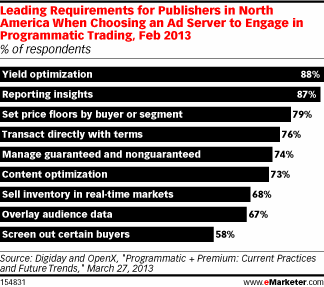You may know it by many different names…”automated guaranteed,” “automated direct,” “automated reserved”…or “programmatic direct.”
Whatever people call it, the process of buying and selling digital media in a direct demand-supply side relationship accounts for a majority of programmatic ad spend.
And that’s despite real-time bidding getting a lot of the hype and attention.
Here’s a breakdown of why it’s good (and sometimes not so good) for publishers.
Yield Optimization with Programmatic Direct
According to Emarketer, the single most important point for those considering programmatic media-selling is yield optimization.

The fact that this places direct or guaranteed methods of media-selling higher on publishers’ list of preferred methods is somewhat ironic given that RTB and open-auction methods were originally developed to help publishers maximize their inventory.
The key here, however, is the profitability. Guaranteed media-selling brings together the possibility of ensuring premium ad slots are filled and the opportunity to get higher prices than would be possible on an open exchange.
The result is an overall higher yield – even if programmatic direct itself does not guarantee that all ad slots will be filled every time a visitor opens a publisher’s page.
Better Insights & Control with Programmatic Direct
Although the rise of data management platforms (DMPs) for complex data segmentation in the media-buying and -selling process has made audience insights and campaign optimization available across the board, direct buying still holds an advantage in this area.
First of all, publishers who have deeper insights into their audiences on premium inventory can better target optimum buyers and negotiate prices based on the value of their traffic.
The direct, controlled relationship between buyer and seller also allows publishers to better measure their revenue from ad inventory, apply predictive modeling and forecasts.
Users of Google DoubleClick’s Programmatic Direct public beta have already noticed an advantage in being able to line up deals with advertisers, provide a better experience for them and foster more trustworthy relationships.
Because advertisers don’t have to wait for campaign data to be routed back through a variety of tools, there is greater, more immediate transparency about impressions served and the audiences that viewed them – which makes advertisers happier and therefore more likely to pay a premium price for direct deals.
Transparency
The bane of digital advertising has been – and continues to be – transparency when it comes to ads served and ads viewed. With an estimated $7.2 billion being lost to bot traffic, that is a serious issue indeed.
Relying more on direct or guaranteed deals can help fight this – not least because advertisers know exactly where to turn to when checking their ad campaigns.
But transparency works for publishers too. Knowing exactly how many impressions are to be served and which creatives will be loaded for which audiences helps optimize their workflow as well and gives them greater control over the context and look of their sites.
Leftovers
The most obvious downside to programmatic direct is that does not offer the guarantee to publishers that all their ad inventory will be sold. Some high-end sites may be able to pull enough clout to attract buyers for every single ad slot on their site.
This is where publishers turn to exchanges to sell of remnant inventory. If a publisher does not put too much stock into the context of the ads being served, the potential “disjointedness” between content controlled by direct buys and that sold on open exchanges may not be a problem.
If, however, the publisher wants to take care of the entire site experience, he or she may be under pressure to control even the remnant inventory being sold – especially to prevent discontent and reduce the likelihood of site visitors using an ad blocker.
Direct access required
The ability to automate insertion orders, ad code configuration and eliminate human error in the entire process is the big advantage of programmatic direct. But this also entails giving potential buyers access to a publisher’s ad server, usually through an API.
While this means more of a direct relationship, it also means coordinating integration and committing to cooperation between publishers and advertisers. With the constantly changing landscape of AdTech, advertisers are more and more reluctant to get tied down to one channel.
The rise of header bidding has also eliminated some of the advantages of programmatic direct for the demand side, meaning that publishers aren’t as able to leverage premium access as they once were.
Video and mobile challenges
The model of programmatic direct – in essence – is an automated version of what used to happen before the days of digital advertising. Publishers and advertisers sat down and hammered out the details of a deal and ads were served – whether in print, radio or TV mediums.
The direct method may offer many advantages – both to publishers and advertisers – for predictability and reliability. But with mobile and video advertising becoming an imperative, old models may have a hard time keeping up.
Advertises realize that their audiences aren’t only on desktops anymore and they don’t just want to see banner ads at the top of a webpage. Campaigns become more complex, mobile inventory more valuable at certain times of day, video inventory in greater and greater demand – all of this makes the exchange model of media-buying and -selling more useful.
Already advertisers have begun to complain that publishers don’t offer enough video inventory on open exchanges.
Whether publishers will give in remains to be seen.







